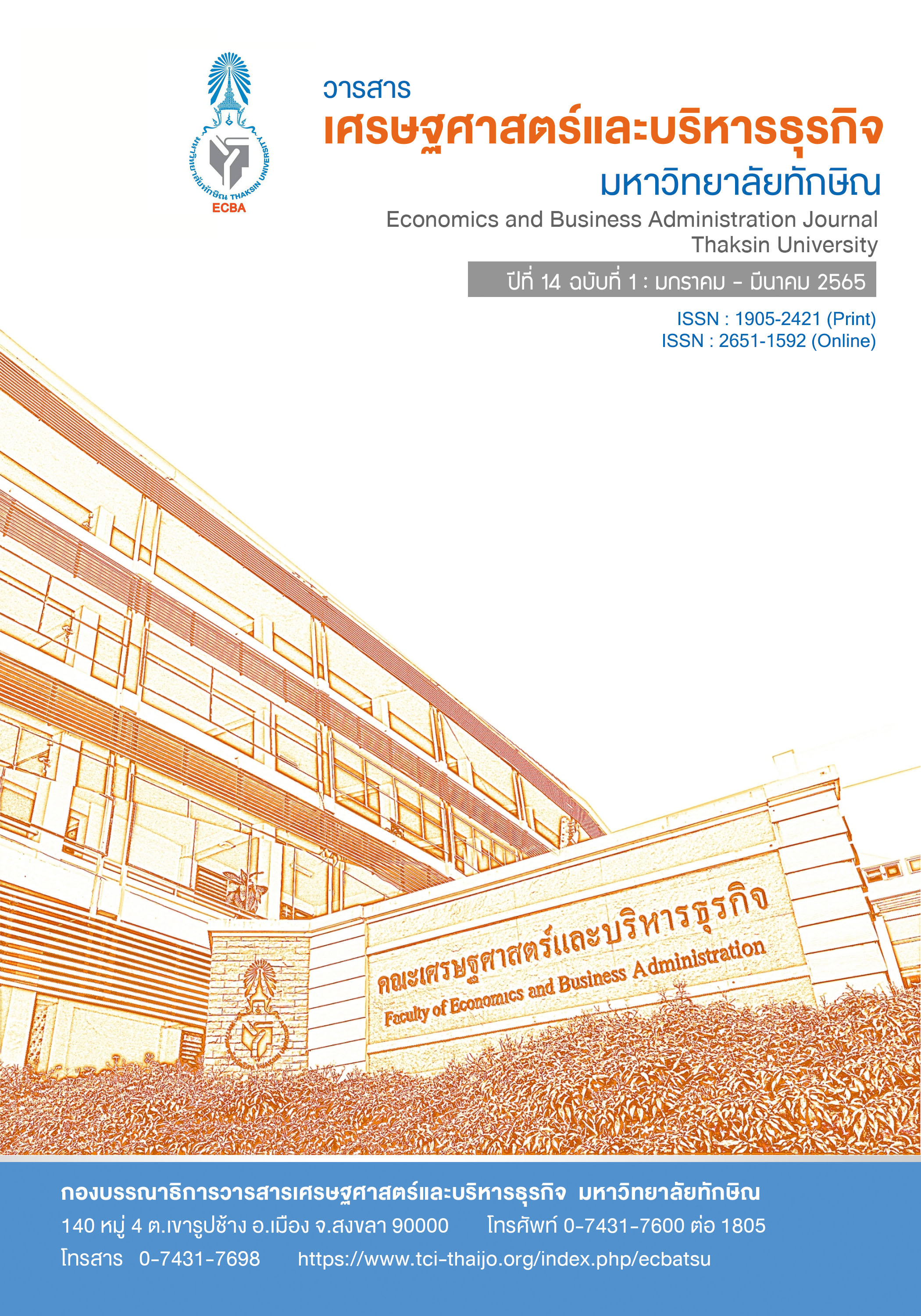The Moderating Role of an Internet Experience on the Elders’ Intention to Adopt Online Shopping
Keywords:
Intention to Adopt, Internet Experience, Online Shopping, Elderly CustomerAbstract
The aim of this study is to investigate the role of moderator variable which is an internet experience that has an impact on the relationship between independent variables which consisting of perceived benefit, ease of use, enjoyment, trust in vendor, and risk and the dependent variable which is intention to adopt online shopping. The population in the study was people aged more than 60 years living in the area of three southern border provinces. The research tool was a questionnaire and was distributed to a sample of 450 elders. Structural equation modeling (PLS-SEM) multigroup analysis, has been employed to perform the difference between high internet experience group and low internet experience groups. The result indicated that there was a correlation of the usefulness and the intention to adopt online shopping in high internet experience group more than low internet experience groups, with a significant difference between the two groups of the elders. However, ease of use, enjoyment, trust in vendor, and risk has no significant difference between the two groups of the elders. As a result, the findings from this study benefit to various groups such as online entrepreneurs, government, academics, and those who wish to further research.
References
Ajzen, I. (1991), Theory of planned behavior. Organization Behavior and Human Decision Process. 50(2), 179-211.
Armstrong, G., & Kotler, P. (Eds.). (2020). Marketing an introduction (14th ed.). England: Pearson Education.
Ashfaq, M., Yun, J., Waheed, A., Khan, M. S., & Farrukh, M. (2019). Customers’ expectation, satisfaction, and repurchase intention of used products online: Empirical evidence from China. SAGE Open, 9(2), 2158244019846212.
Bertea, P. E., & Zait, A. (2013). Perceived risk vs. intention to adopt e-commerce a pilot study of potential moderators. Trziste/Market, 25(2), 213-229.
Chen, H., Rong, W., Ma, X., Qu, Y., &Xiong, Z. (2017). An extended technology acceptance model for mobile social gaming service popularity analysis. Mobile Information Systems, 2017.
Corbitt, B. J., Thanasankit, T., & Yi, H. (2003). Trust and e-commerce: a study of consumer perceptions. Electronic Commerce Research and Applications, 2(3), 203-215.
Davis, F. D. (1989). Perceived usefulness, perceived ease of use, and user acceptance of information technology. MIS quarterly, 319-340.
Department Of Provincial Administration.(2018). Statistics of the elderly in Thailand, 77 provinces as December 31, 2017. Retrieved from http://www.dop.go.th/download/knowledge/th1533055363-125_1.pdf
Electronic Transactions Development Agency. (2020). Survey of internet user behavior in 2020. Retrieved from https:// https://www.etda.or.th/th/newsevents/pr-news/ETDA-released-IUB-2020.aspx
Electronic Transactions Development Agency. (2021). Summary of online complaints. Retrieved from https://www.etda.or.th/th/newsevents/pr/1212-OCC-Statistic-2020.aspx
Eneizan, B. I. L. A. L., Alsaad, A. B. D. A. L. L. A. H., Abdelbaset Alkhawaldeh, H. N., & Rawash, O. E. (2020). E-wom, trust, usefulness, ease of use, and online shopping via websites: the moderating role of online shopping experience. Journal of Theoretical and Applied Information Technology, 98(13), 2554-2565.
Faculty of Nursing, Mahidol University. (2021). Risks and impacts on the elderly during Covid-19. Retrieved from https://www.dmh.go.th/news-dmh/view.asp?id=30794
Fishbein, M., & Ajzen, I. (1975). Belief, attitude, intention, and behavior: An introduction to theory and research. Philosophy and Rhetoric, 10(2).
Gefen, D., Karahanna, E., & Straub, D. W. (2003). Trust and TAM in online shopping: An integrated model. MIS Quarterly, 27(1), 51-90.
Hair, J.F., Hult, G.T.M., Ringle, C.M., Sarstedt, M. (2013). A primer on partial least squares structural equation modeling (PLS-SEM). Sage, Thousand Oaks.
Hassanein, K., & Head, M. (2007). Manipulating perceived social presence through the web interface and its impact on attitude towards online shopping. International Journal of Human-Computer Studies, 65(8), 689-708.
Henseler, J., Ringle, C. M., & Sarstedt, M. (2015). A new criterion for assessing discriminant validity in variance-based structural equation modeling. Journal of The Academy of Marketing Science, 43(1), 115-135.
Krejcie, R. V., & Morgan, D. W. (1970). Determining sample size for research activities. Educational and psychological measurement. 30(3), 607-610.
Lee, M. C. (2009). Predicting and explaining the adoption of online trading: An empirical study in Taiwan. Decision Support Systems, 47(2), 133-142.
Lin, K. M. (2011). E-learning continuance intention: Moderating effects of user e-learning experience. Computers and Education, 56(2), 515-526.
Macik, R., & Macik, D. (2016). Trust and product/sellers reviews as factors influencing online product comparison sites usage by young consumers. Managing Global Transitions, 14(2), 195-215.
Miller, R. L. (2015). Rogers' innovation diffusion theory (1962, 1995). In Information seeking behavior and technology adoption: Theories and trends (pp. 261-274). IGI Global.
Nabot, A., Garaj, V., & Balachandran, W. (2018). Consumer attitudes toward online shopping: an exploratory study from Iordan. In Mobile commerce: concepts, methodologies, tools, and applications (pp. 1110-1123). IGI Global.
Nielsen (2016).The new age of Thais. Retrieved from https://www.nielsen.com/th/th/press-room/2016/new-age-of-thais.html
Pappas, I. O., Pateli, A. G., Giannakos, M. N., & Chrissikopoulos, V. (2014). Moderating effects of online shopping experience on customer satisfaction and repurchase intentions. International Journal of Retail and Distribution Management.42(3), 187-204.
Positioning (2016), “Elderly market” Major market trends but overlooked by marketers? Retrieved from https://positioningmag.com/1100674
Rani, T. S., & Sripathi, N. (2017). Online shopping purchase patterns with special reference to demographic and informational influence. International Journal of Social Sciences and Management, 4(1), 38-43.
Rasool, A., Gupta, V., Slathia, B., & Mahajan, G. (2017). Online shopping adoption and influencing factors: A study in Karnataka. Apeejay-Journal of Management Sciences and Technology, 42, 29-40.
Songsom, A. (2018). Causal factors of electronic loyalty: A case study of online purchasing of the generation C consumers.Veridian E-Journal, Silpakorn University. 11(1), 2515-2529.
Statista .(2021). Leading countries based on retail e-commerce sales growth in 2020. Retrieved from https://www.statista.com/statistics/266064/revenue-growth-in-e-commerce-for-selected-countries
Swinyard, W. R., & Smith, S. M. (2003). Why people (don't) shop online: A lifestyle study of the internet consumer. Psychology and Marketing, 20(7), 567-597.
The Foundation of Thai Gerontology Research and Development Institute. (2019). Situation of the Thai elderly 2018. Printery Co., Ltd. Nakorn Pathom.
Zikmund, W. G., Carr, J. C., & Griffin, M. (2013). Business Research Methods. Cengage Learning.
Downloads
Published
How to Cite
Issue
Section
License
Copyright (c) 2022 Economics and Business Administration Journal Thaksin University

This work is licensed under a Creative Commons Attribution-NonCommercial-NoDerivatives 4.0 International License.




